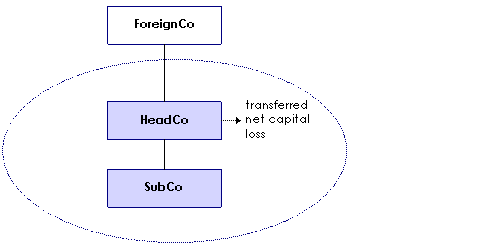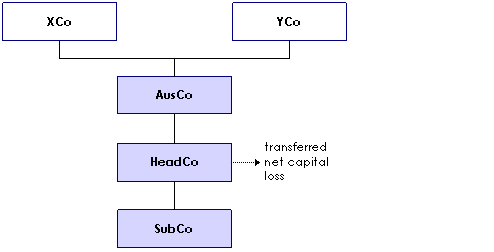Consolidation Reference Manual
You can still refer to the Consolidation reference manual for consolidation information that has not been impacted by changes in the legislation.
C3 Losses
C3-4 Worked example - loss utilisation
Amount that can be utilised
C3-4-450 Cessation of a consolidated group - application of the same business test to the former head company
Description
This example illustrates how the same business test (SBT) is applied to the former head company of a consolidated group [F1] where:
- •
- the consolidated group ceases to exist, and
- •
- the former head company of the consolidated group seeks to utilise losses it held at the time the group ceased to exist.
This example specifically relates to the situation where:
- •
- all of the membership interests of the head company of the consolidated group are acquired by a resident company, and
- •
- the resident company does not make a choice to form another consolidated group.
- •
- eligibility to be a head company → 'Eligibility tests and rules', C1-1
- •
- the head company's ability to utilise losses → 'Treatment of losses', C3-1
Commentary
Utilisation of losses by former head company
Where the head company of a consolidated group ceases to meet the requirements [F2] to be the head company of a consolidated group, the consolidated group ceases to exist → subsection 703-5(2), ITAA 1997. This would occur, for example, where the head company is acquired by a resident company.
Where the consolidated group ceases to exist, the losses of the group are retained by the former head company.
If all of the membership interests in the former head company are acquired by a resident company that does not make a choice to form another consolidated group, the former head company will exist as a stand-alone entity. The consequences for the utilisation of losses in subsequent income years by the former head company are as follows:
- •
- The continuity of ownership test (COT) would be failed (as a result of the 100% change in the membership interests of the head company) at the time the consolidated group ceased to exist in respect of each loss being sought to be utilised.
- •
- The SBT in section 165-13 would need to be satisfied by the former head company for the losses to be utilised.
The single entity rule and the SBT
The single entity rule in section 701-1 applies when examining the business of the former head company at a time that it was the head company of the consolidated group. Under this rule, subsidiary members are taken to be part of the head company. This means the business of the head company consists of one overall business that includes all the activities conducted by subsidiary members of the group.
From the time the consolidated group ceases to exist the single entity rule does not apply. The business of the former head company then consists of the former head company's activities as a stand-alone entity.
The former head company can only utilise its losses if the business it carried on at the relevant times remains unchanged.
Example
Facts
HCo and its wholly-owned subsidiary SubCo form a consolidated group on 1 July 2003 (Figure 1). HCo is wholly owned by the non-resident company ForeignCo. A net capital loss was transferred from HCo to itself at the time the group was formed.

AusCo, a resident company, [F3] acquires 100% of the shares in HCo (Figure 2). This is the only ownership change that has impacted on the consolidated group since its formation. The change in beneficial ownership of the shares, for the purposes of the consolidation membership rules, occurs at the start of 15 August 2004. At that time, HCo is no longer eligible to be the head company of the consolidated group as it is a wholly-owned subsidiary of an entity that meets the requirements to be the head company of a consolidated group.
The consolidated group therefore ceases to exist from 15 August 2004 and the loss remains with HCo for possible utilisation. AusCo does not choose to form a consolidated group with its new wholly-owned subsidiaries.
HCo makes a capital gain in the year ended 30 June 2005 and seeks to utilise the transferred net capital loss.

Calculation
Loss utilisation test
The company loss recoupment rules in Division 165 determine whether the loss held by HCo may be utilised in the year ended 30 June 2005.
The change in beneficial ownership of HCo on 15 August 2004 (which resulted in the cessation of the consolidated group) means that HCo fails the COT in respect of the net capital loss being sought to be utilised. Therefore, the loss held by HCo can only be utilised if the SBT is satisfied.
The SBT must be satisfied for:
- •
- the SBT period, which is the income year ended 30 June 2005, and
- •
- immediately before the test time on 14 August 2004 (the latest time that HCo could show that it satisfied the COT).
Figure 3 illustrates these testing points for HCo.

The business carried on by HCo immediately before the test time relates to a time that the consolidated group still exists. At that time, HCo is the head company of the consolidated group and, pursuant to the single entity rule, the business of the entire consolidated group (comprising HCo and SubCo) needs to be examined.
In the income year ended 30 June 2005 (the SBT period):
- •
- the single entity rule applies to HCo for the time the consolidated group still exists - i.e. from 1 July 2004 to 14 August 2004 - and therefore the relevant business for that time comprises the activities of the entire consolidated group, and
- •
- the single entity rule does not apply to HCo from the time that the consolidated group ceases to exist on 15 August 2004, and therefore the business for the time from 15 August 2004 to 30 June 2005 comprises the activities of HCo as a stand-alone entity and excludes the activities of SubCo.
The net capital loss can only be utilised by HCo in the year ended 30 June 2005 if the business of HCo for these testing times has remained unchanged.
References
Income Tax Assessment Act 1997:
Revision history
Section C3-4-450 first published 26 June 2007.
Proposed changes to consolidation
Proposed changes to consolidation announced by the Government are not incorporated into the Consolidation reference manual until they become law. In the interim, information about such changes can be viewed at:
- •
- http://assistant.treasurer.gov.au (Assistant Treasurer's press releases)
- •
- www.treasury.gov.au (Treasury papers on refinements to the consolidation regime).
Current at 26 June 2007
The principles set out in this example would also affect the application of the SBT to the former head company of a multiple entry consolidated (MEC) group.
Set out in item 1 of the table in subsection 703-15(2).
That meets the requirements (in item 1 of the table in subsection 703-15(2)) to be a head company.
Copyright notice
© Australian Taxation Office for the Commonwealth of Australia
You are free to copy, adapt, modify, transmit and distribute material on this website as you wish (but not in any way that suggests the ATO or the Commonwealth endorses you or any of your services or products).
